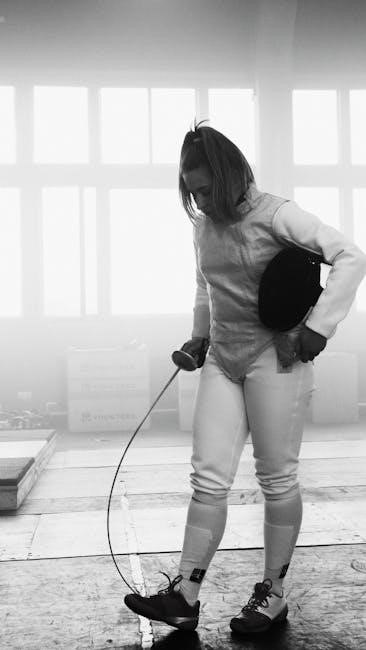The Woman Warrior by Maxine Hong Kingston is a groundbreaking memoir blending autobiography and Chinese folklore, published in 1976․ It explores themes of identity, culture, and gender, offering a poignant account of growing up Chinese-American․
1․1 Brief Overview
The Woman Warrior: Memoirs of a Girlhood Among Ghosts is a seminal work by Maxine Hong Kingston, first published in 1976․ This innovative memoir blends personal narrative with Chinese folklore, exploring themes of identity, culture, and gender․ The book is structured into five chapters, each focusing on the stories of significant women in Kingston’s life, including her mother, aunts, and herself․ Through these narratives, Kingston integrates “talk-stories”—a mix of family histories, myths, and legends—to convey the complexities of growing up Chinese-American․ The memoir delves into the tensions between cultural traditions and personal aspirations, offering a powerful exploration of self-discovery and belonging․ Its unique blend of autobiography and mythology has made it a landmark in American literature․
1․2 Historical Context
The Woman Warrior was published in 1976, a time of significant social change in the United States․ The memoir reflects the experiences of Chinese Americans during the mid-20th century, particularly the challenges of cultural assimilation and identity formation․ Kingston’s work emerged during a period of growing interest in multiculturalism and feminism, making it a pivotal text in both Asian-American and feminist literature․ The book also draws on the historical backdrop of China’s political upheavals, such as the Communist takeover in 1949, which influenced the migration of Kingston’s family to the U․S․ By weaving personal and collective histories, Kingston provides insight into the struggles and resilience of Chinese-American communities during this era․

Author Background
Maxine Hong Kingston, born Maxine Ting Ting Hong in 1940, is a Chinese-American writer․ She grew up in California, the daughter of Chinese immigrants, blending her heritage with American culture, inspiring her unique literary voice blending memoirs and folklore․
2․1 Personal History
Maxine Hong Kingston was born on October 27, 1940, in Stockton, California, to Chinese immigrant parents․ She was the third of eight children in a family that operated a laundry business․ Kingston’s early life was shaped by the cultural duality of her Chinese heritage and American surroundings․ Her mother, a skilled storyteller, shared tales of Chinese myths and family history, which deeply influenced Kingston’s writing․ She grew up navigating the tensions between her parents’ traditional values and the realities of American life․ Kingston attended the University of California, Berkeley, where she developed her writing skills․ Her unique background and experiences laid the foundation for her literary work, blending personal narrative with cultural folklore․
2․2 Cultural Influences
Maxine Hong Kingston’s work is profoundly shaped by her dual identity as a Chinese-American woman․ Her writing reflects the rich storytelling traditions of her Chinese heritage, particularly through the “talk-stories” her mother shared․ These tales of myth, history, and family legacy influenced her blending of autobiography and folklore in The Woman Warrior․ Additionally, Kingston’s experiences as an immigrant’s daughter in America exposed her to cultural clashes and the struggle to reconcile two worlds․ Her work often explores themes of identity, belonging, and the immigrant experience, making her a pivotal figure in Asian-American literature․ Kingston’s unique voice bridges cultural divides, offering a fresh perspective on the complexities of multicultural identity․

Book Structure
The Woman Warrior innovatively blends memoir and folklore, structured into chapters integrating personal narratives with mythological tales, reflecting Kingston’s postmodern approach to storytelling and cultural identity․
3․1 Narrative Technique
Maxine Hong Kingston employs a unique narrative technique in The Woman Warrior, blending memoir with mythology and folklore․ The book uses a non-linear structure, weaving together personal experiences, family stories, and mythical tales․ Kingston’s narrative voice shifts between first-person reflections and third-person retellings of legends, creating a layered exploration of identity․ This technique allows her to bridge the gap between her Chinese heritage and American upbringing, while also examining gender roles and cultural expectations․ By integrating “talk-stories” and mythological figures like Fa Mu Lan, Kingston crafts a postmodern narrative that challenges traditional storytelling conventions, offering a rich and multifaceted exploration of her experiences as a Chinese-American woman․
3․2 Integration of Folktales
The Woman Warrior masterfully integrates traditional Chinese folktales, known as “talk-stories,” to explore themes of identity and cultural heritage․ Kingston weaves these stories into her memoir, using them to connect her personal experiences with the broader Chinese diasporic narrative․ The most prominent folktale is that of Fa Mu Lan, the legendary woman warrior, who serves as a symbol of female strength and resilience․ These stories not only enrich the narrative but also allow Kingston to bridge the cultural divide between her American life and her Chinese roots․ By reimagining these tales, she creates a space where personal and collective histories intersect, offering a vivid exploration of identity, duty, and the immigrant experience․

Major Themes
The Woman Warrior explores themes of identity, gender roles, and cultural conflict, using ghosts as metaphors for the immigrant experience and feelings of displacement․
4․1 Identity
The Woman Warrior delves deeply into the theme of identity, particularly the complexities of being a Chinese-American woman․ Kingston navigates the duality of her heritage, blending personal experiences with Chinese folklore to explore her sense of self․ The memoir reflects her struggles with cultural expectations and the tension between her American upbringing and Chinese traditions․ Through stories of her family and mythical figures like Fa Mu Lan, Kingston examines how identity is shaped by history, culture, and gender․ The concept of “ghosts” serves as a metaphor for the lingering presence of her ancestral past and the feeling of displacement in a new world․ Kingston’s journey of self-discovery highlights the challenges of finding one’s voice and place in a multicultural society․
4․2 Gender Roles
The Woman Warrior critically examines the rigid gender roles imposed by Chinese culture, highlighting the suppression of women’s voices and autonomy․ Kingston portrays the societal expectations placed on women, such as silence, obedience, and domesticity, contrasted with the mythical figure of Fa Mu Lan, a female warrior who defies these norms․ The memoir exposes the harsh realities faced by women in Kingston’s family, including her aunt, who was shunned for bearing no sons․ Kingston’s own struggles with these gender norms are evident as she navigates her identity and challenges the limitations placed on her․ The book serves as a powerful critique of patriarchal traditions, advocating for women’s empowerment and the reclaiming of their stories and voices․ This theme resonates deeply, offering a feminist perspective on cultural and personal identity․

Cultural Significance
The Woman Warrior bridges Chinese folklore and American identity, offering a unique perspective on the immigrant experience․ Its exploration of cultural duality and personal history remains deeply impactful․
5․1 Chinese-American Experience
The Woman Warrior vividly portrays the challenges of growing up Chinese-American, blending personal narrative with cultural myths․ Kingston’s work captures the tension between traditional Chinese values and American modernity, reflecting her struggles with identity and belonging․ Through her mother’s “talk-stories,” Kingston bridges the gap between two worlds, offering a powerful exploration of cultural duality․ This memoir provides a unique lens into the immigrant experience, highlighting the complexities of navigating multiple identities․ Kingston’s portrayal resonates deeply, making it a seminal work in understanding the Chinese-American journey․ Her storytelling weaves together personal and cultural histories, creating a rich tapestry of experience․
5․2 Ghosts as Metaphors
In The Woman Warrior, Maxine Hong Kingston employs ghosts as a profound metaphor for the cultural and emotional dislocation she experiences․ These spectral figures symbolize the lingering presence of her Chinese heritage in an American context, as well as the haunting memories of her family’s past․ Ghosts represent the unseen forces that shape her identity, embodying the tension between tradition and modernity․ Kingston’s use of this imagery reflects her struggle to reconcile her dual heritage, where the “ghosts” of her mother’s stories and the expectations of her ancestors coexist with her American upbringing․ This metaphorical device underscores the fragmented nature of her identity and the immigrant experience, where the past and present, China and America, intersect in complex ways․ Ghosts, thus, become a powerful symbol of her journey toward self-understanding and cultural belonging․

Critical Reception
The Woman Warrior by Maxine Hong Kingston received acclaim for blending memoir and mythology, winning the National Book Critics Circle Award․ It sparked debates on cultural authenticity․

6․1 Awards
The Woman Warrior by Maxine Hong Kingston earned the National Book Critics Circle Award in 1976, recognizing its innovative blend of memoir and mythology․ Kingston also received the National Medal of Arts in 1997 and the National Humanities Medal in 1998 for her contributions to literature․ Her work China Men won the National Book Award in 1981, further cementing her literary acclaim․ These accolades highlight her groundbreaking storytelling and cultural impact, solidifying her place in American literature․
6․2 Controversies
The Woman Warrior has faced criticism from some Chinese-American communities for its portrayal of cultural practices and family secrets․ Some argued that Kingston’s blending of fact and fiction misrepresented Chinese culture․ Additionally, her use of family stories raised concerns about privacy and cultural authenticity․ Despite these criticisms, the book remains a landmark work in multicultural literature, praised for its bold narrative style and exploration of identity․ The controversies highlight the challenges of representing diverse experiences in literature while navigating cultural sensitivities and personal narratives․

Themes Continued
The Woman Warrior delves into themes of cultural conflict and silence, exploring the protagonist’s struggle to reconcile Chinese traditions with American identity, highlighting the power of voice and memory․
7․1 Cultural Conflict
Cultural conflict is a central theme in The Woman Warrior, as Kingston navigates the tension between her Chinese heritage and American upbringing․ Her experiences reflect the challenges of assimilation, where traditional values often clash with modern expectations․ The protagonist’s journey illustrates the internal struggle of balancing two worlds, highlighting the complexities of identity formation․ Kingston’s use of folklore and personal narrative underscores the broader immigrant experience, where cultural duality shapes self-perception and societal interactions․ This theme resonates deeply, offering insight into the universal struggle of maintaining cultural roots while adapting to a new environment․
7․2 Silence and Voice
Silence and voice are powerful themes in The Woman Warrior, as Kingston explores the tension between speaking out and being silenced․ The protagonist’s journey reflects the struggle of finding her voice in a world where women, particularly Chinese-American women, are often expected to remain quiet․ Kingston examines how cultural and familial expectations enforce silence, while personal and collective stories offer a path to expression․ The protagonist’s growth is marked by her increasing ability to articulate her identity and challenge societal norms․ This theme highlights the transformative power of voice, both as a means of self-liberation and as a way to bridge cultural divides․ Kingston’s own narrative becomes a testament to the importance of breaking silence and reclaiming one’s story․

Reader’s Resources
The Woman Warrior is widely available in PDF format, offering convenient access to Kingston’s seminal work․ Study guides and critical analyses complement the text, enhancing reader understanding․
8․1 PDF Availability
The full text of The Woman Warrior by Maxine Hong Kingston is accessible in PDF format, allowing readers to explore her blend of memoir and mythology digitally․ This accessibility has made the book widely available for academic and personal use, ensuring its enduring relevance in literary studies and cultural discussions․
8․2 Study Guides
Detailed study guides for The Woman Warrior are widely available, offering in-depth analyses of themes, characters, and symbols․ These resources, including those from SparkNotes, provide summaries of key chapters, character descriptions, and explorations of motifs like identity and cultural conflict․ Students can access guides that break down Kingston’s narrative techniques and the integration of folklore, aiding in understanding the book’s complex structure․ Additionally, many guides include discussion questions and essay prompts, making them invaluable for academic preparation․ These tools are regularly updated to reflect new critical perspectives, ensuring comprehensive support for readers engaging with Kingston’s seminal work․

Legacy
The Woman Warrior has left an enduring impact on literature, inspiring future writers and becoming a cornerstone of feminist and multicultural studies in educational curricula nationwide․
9․1 Cultural Impact
The Woman Warrior has profoundly influenced Chinese-American literature, offering a voice to silenced experiences and challenging traditional narratives․ Kingston’s work bridges Chinese folklore and American reality, resonating deeply with multicultural audiences․ By weaving personal and mythological stories, she highlights the struggles of cultural identity, fostering empathy and understanding․ The book’s innovative style has inspired countless writers to explore their dual heritage, making it a cornerstone of feminist and multicultural studies․ Its enduring relevance underscores the importance of diverse storytelling in shaping cultural dialogue and preserving heritage for future generations․
9․2 Educational Use
The Woman Warrior is widely taught in educational institutions, particularly in courses on American literature, women’s studies, and multicultural studies․ Its exploration of identity, gender, and cultural conflict resonates with students, fostering discussions on diversity and personal narrative․ The book’s unique blend of memoir and folklore makes it a valuable resource for teaching critical thinking and creative writing․ Many educators use the PDF version of the text for classroom convenience, alongside study guides that provide historical context and analytical frameworks․ By incorporating Kingston’s work, educators help students engage with themes of cultural identity and the immigrant experience, enriching their understanding of multicultural perspectives in American society․
